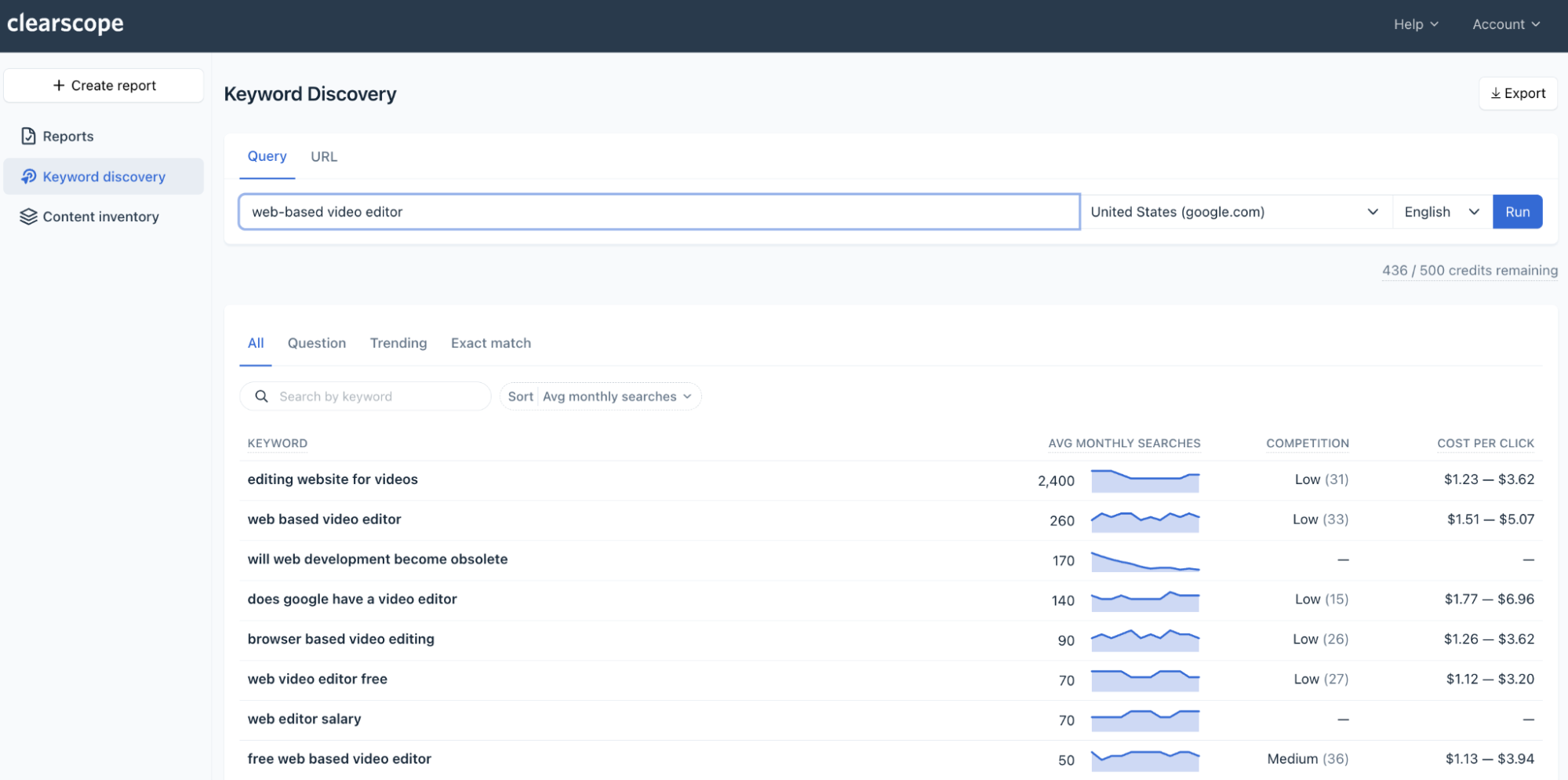
Table of Contents
Join our newsletter
Get access to trusted SEO education from the industry's best and brightest.
SEO content development involves creating, promoting, and managing site content so it ranks and moves to the first page of search engine results — along with performing well with target audiences.
There are five core elements to this process:
Keyword research and developing a content plan.
Writing SEO-friendly content that appeals to search intent and caters to Google’s ranking requirements.
Following on-page and off-page SEO strategies to promote content and give it the best chance of out-performing SERP competitors.
Reporting on the success of content to understand which strategies and pieces of content perform well for you (then using these insights to guide future keyword research and content development).
Monitoring and updating content to remain competitive.
Our post walks through each stage of the process so you can understand how to build a keyword schedule, tackle topics, and measure ROI from content marketing. We’ve also written comprehensive guides on these topics and will link to those within so you can continue researching the best practices for each step.
Clearscope’s Keyword Discovery, Content Reports, and Content Inventory support each stage of SEO content creation. Our features guide topic research and competitive analysis, then provide clear recommendations to streamline content writing and implement on-page SEO strategies. Teams have all the tools to produce top-ranking, high-quality content with ease.
Note: Clearscope is our product. We’re proud of what we’ve built and believe we have the best content optimization and monitoring platform on the market. Request a personalized demo.
1. Develop a content plan with target keywords
First, you want to determine specific keywords to rank for — you can brainstorm keywords by thinking about:
Your content marketing goals. Do you want to promote specific products? Build your brand reputation? Increase sales in a particular target market? Improve local SEO?
Your brand’s products and services. What offerings do you provide? What problems do you solve? For example, if you manage content marketing for an online video editing software, you’d want to look at keywords like “web-based video editor.”
Keywords that competitors target. What target audiences and conversations do competitors target? Does it make sense to introduce your name in those conversations?
Your ideal customers or target audiences.
Current events and viral topics.
Overall, think about the opportunities that show business value and conversion potential. This way, you can get in front of the right readers (potential customers) and see success from content marketing sooner.
You can read more about keyword research strategies here: Why is Keyword Research Important?
As you identify opportunities and begin building your content plan, it’s also a good idea to pinpoint topic clusters. This can simplify keyword research and help you create a more structured content plan.
The SparkNotes: Topic clusters are groups of related content — typically, there’s a “parent” or “hub” article, then a bunch of related articles that expand upon the core content (a.k.a. The “child” posts or “spokes”).
For example, if you were targeting “web-based video editor” as a category keyword, you could also write a post about “how to edit videos online” and have the two play off each other. Creating smart topic clusters helps you uncover long-tail keywords, guides internal linking, and improves domain authority (as Google can see you have comprehensive content on particular topics and identify your brand as a reliable name in the space).
Before you finalize target keywords and begin writing new content around these opportunities, audit the content that already exists on your site.
Auditing site content helps you avoid keyword cannibalization and make better use of existing resources — as you may find opportunities to re-optimize existing content to rank for new keywords.
You can read more about keyword mapping here.
Clearscope’s Keyword Discovery feature lets you research target keywords about particular subjects, industries, or search queries. Type any word or phrase into the search bar to see the related keyword options. We also show metrics like search volume, keyword difficulty, and CPC to help you plan organic content and identify opportunities for PPC campaigns.

Read more: G2 Launches an Intent-Focused Content Strategy with Clearscope
2. Write SEO-optimized content that caters to search intent & hits on Google ranking criteria
Now, you want to think of strategies to target each keyword and write SEO-optimized content.
We already touched on evaluating existing content… so how do you approach new topics?
First, you want to perform in-depth research on the keyword and see who you’re competing with in search engine results pages. What brands and sites do you see? What types of content do they have published on the topic? How do you fit into this conversation?
Learn how to perform competitive content analysis.
Also, think about search intent; this is arguably the most important factor when researching content. What is the goal of the searcher? How can you interest and engage them?
Begin thinking about ways to outperform SERP competitors.
Read more: Your Guide to Analyzing User Intent for Better SEO Results
Next, consider the keyword and type of website content you should produce: should you target the keyword with a blog post? Or does it make better sense to build a landing page?
Then, after you understand readers’ goals and how to approach the keyword, you can delve into creating content. And Clearscope Content Reports support the entire writing process because:
We have competitive analysis tools to guide the research we discussed above.
Reports show competitor outlines and heading suggestions so you can quickly map out content with relevant sections and clear structure.
Note: When building outlines, make sure to use the correct headings. Use H1s for titles, H2s for main sections, and H3s for subheadings.
Read more: How To Write SEO Content Briefs and Outlines (Video + Template)
We tell you what topics to cover, questions to answer, and terms to include so you can weave SEO recommendations into the natural writing process.

Our reports show real-time progress and streamline workflows so you can optimize content for search engines while you put together your draft.
Read more: Animalz Saves 3 Hours per Article with Clearscope
With Clearscope, editing content is much easier: You can follow standard processes (check for spelling and grammar mistakes, tone of voice, and readability) and incorporate the remaining report suggestions as you polish up.
Clearscope Content Reports are convenient for a few reasons:
We don’t overload you with recommendations, so it’s easy to incorporate our suggestions without spending hours optimizing content.
We include mostly single-term suggestions so you can cover relevant topics without sounding robotic.
We help you avoid keyword stuffing by providing unique suggestions and accepting variations of recommended terms/phrases.
You can learn more about this step in these guides:
Before finalizing and publishing content, you should incorporate on-page SEO elements to ensure you follow all SEO best practices. This includes:
Adding internal links — 5 Effective Internal Linking Strategies to Improve Your SEO.
Linking to other (credible, authoritative) sites to show Google you reference reliable resources during your research.
Using strategic, clear anchor text with internal and external links.
Adding supporting media (like images, infographics, or videos) to content.
Using descriptive alt-text with in-line media.
Drafting your post’s SEO title and meta description (with target keywords).
Adding FAQs to answer common reader questions and improve the chances of being pulled as a featured snippet.
Read more: 10-Step Checklist for SEO Content Editing (with Guided Reports)
3. Implement off-page strategies to promote content
There are a few ways to improve your Google rank post-publishing:
First, build backlinks to content — it’s best to establish link-building relationships with authoritative sites so backlinks can “boost” content. Links from sites with poor domain ratings won’t necessarily help content rankings (and could actually have a negative impact). You should also ensure that backlinks are placed in relevant contexts and tie back to your site’s content.
Read more: How To Get Good Backlinks: A Step-by-Step Guide
You should promote your content on social media — this won’t necessarily improve SEO, but it does help build brand awareness and drive visitors to your site. And if readers stay engaged with content and continue the journey on your site, this user activity could indicate to Google that content is well-written, relevant, and helpful — and that could improve search engine performance.
Another strategy to build brand awareness and authority is to update your Google Business Listing. You can even share new content through your business listing by posting updates. Sharing background about your brand and publishing SEO-friendly content about relevant industry topics can help Google (and Googlers) see your brand as more reliable and trustworthy.
Read more: 12 Content Promotion Strategies To Strengthen Your Content Marketing
Don’t forget technical SEO
If you notice that content isn’t ranking well (or moves up search engine results very slowly), you should analyze your site for technical SEO issues.
SEO crawlers like Screaming Frog (you might also consider enterprise solutions like seoClarity) review your site structure and page content to pinpoint issues that impact performance and website rankings. They look for problems with page indexing, URL structure issues, broken links, expired redirects, usability issues, and more.
These tools are convenient because they can identify problems and provide feedback on how to fix them — you can quickly work through SEO recommendations and improve your overall website health. (However, you still may need the guidance of an SEO expert to handle some of the more complex suggestions.)
Plus, Screaming Frog’s Spider Crawler is free to use, and you can configure it to audit a variety of criteria.
In addition, you can use Google Search Console (GSC) to check core web vitals and implement Google’s recommendations to improve site performance on both desktop and mobile.
(More on this tool in the next section…)
4. Report on the success of content to understand what’s working for you (and course-correct as needed)
An absolutely critical step of SEO content development is reporting: although this might not feel like it’s part of “creating content” — the insights you gather at this stage are essential to measure ROI from website content and guide future content development (more specifically, the three steps we reviewed above).
If you just blindly publish content and only pay attention to rankings, you can’t hone in on what’s working for you and what isn’t. For example, if you publish content and push it to page one of search results, but nobody engages with it or converts from it, is it really that successful?
That’s why we suggest reporting on rankings, organic traffic, and conversion rates from website content, so you can:
Monitor how content performs in search engines.
See which keywords you rank highly for.
Determine if content is persuasive enough to draw readers in. Are they selecting your content vs. other options in search engine results?
Understand its overall value. Are readers engaging with content or immediately leaving the page? Do readers click to other site pages or convert from content?
This feedback can tell you the following:
Which categories and keywords are most relevant to your brand offerings, unique selling points, and target audiences.
Which content types are most successful. Which web pages draw in the most traffic and conversions? Can you identify themes or patterns amongst successful content pieces that you can apply in the future?
Which promotional strategies are most effective at improving rankings and driving traffic.
From there, you can plan more strategic keywords, write more successful content, and focus on the most effective methods to promote content.
There are several tools you can use to report on content. Here’s a breakdown:
You can use Semrush or Ahrefs to build custom rank trackers and see where content ranks for particular keywords.
Google Search Console and Google Analytics show traffic breakdowns to measure organic vs. paid traffic and understand where visitors come from.
Google Analytics also has reporting features to measure conversions from content — you can create goals to track specific user engagement metrics (like contact form fills, demo requests, or actual sales) and identify which content drives new business.
5. Monitor & re-optimize content to remain competitive
The last step is maintenance: website content requires monitoring and updates to stay competitive.
It’s generally obvious that content needs periodic refreshers to remain up-to-date with current details, links, and imagery. However, timing updates can prove challenging: some SEO guides say to update content on a solid schedule (every six months or year), while others say to monitor traffic and rankings and update content when you notice performance slip.
That’s why we’ve added a Content Inventory tool to monitor your web page’s SEO scores and show you when content is becoming “outdated.” This way, you can refresh content before rankings begin to fall or traffic declines.
Read more: What Is Content Decay? Plus 5 Top Strategies To Address It
Our Content Inventory dashboard is easy to use (and we have custom plans, so you can track as many web pages as you like in this tool). Simply add the page URL and target keyword — we save the content to your dashboard and display the current SEO score.

We consider Google algorithm updates and monitor competitor sites to calculate the most recent content grades.
You can schedule content for updates when you notice scores slip — and use Clearscope Content Reports to guide re-optimization: just generate a new report for the keyword, paste your content, and follow our recommendations to bring it up to speed. Updates move faster (and you can see better results from your efforts).
Note: We also have integrations with Google Docs and WordPress, so you can further streamline the process by editing and updating content directly in those tools.
You can also follow the tips in these guides to update site content effectively:
FAQs on SEO content development
How long does it take to rank on Google?
This answer can depend on several things, including website health, content quality, and off-page elements like backlinks; however, you can typically expect to see your content rank in top search positions between 6 to 12 months after publishing.
In other words, you shouldn’t expect overnight results — and anyone claiming they can achieve instant rankings is likely overpromising.
Learn more in our guide: How Long Does It Take to Rank In Google With SEO Techniques?
What are the important Google ranking factors?
Google’s algorithm is constantly updated — Google developers say small updates are rolled out every day. But here are ten fundamental criteria it considers:
Domain age, URL, and authority
Page content
On-page optimization
Internal links
External links
Backlinks
User experience
Website and page speeds
Mobile usability
Site security
What are the three essential components of SEO strategy?
The three components of search engine optimization are on-page SEO, off-page SEO, and technical SEO.
On-page SEO includes content development and page content — page titles, headings, keywords, internal and external links, and in-line media.
Off-page SEO refers to your strategies to promote content— backlinks and referring domains impact off-page SEO.
Technical SEO involves back-end website elements like URL structure, redirects, and site security. This part of SEO also includes page load times, mobile usability, and desktop performance.
Use Clearscope to guide SEO content development
Clearscope offers user-friendly tools to support content development and simplify team workflows:
Our keyword research tools provide visibility into what target audiences are searching so you can identify valuable opportunities, build your content plan, and schedule topics.
Reports walk you through content creation — they show you how to outline content and display real-time progress as you write to double-check you’re covering relevant information and incorporating important keywords.
Content Inventory lets you monitor web pages to maintain rankings — you can check that content performs well for you and make strategic updates to prevent content decay.
Everything in our platform is shareable (with no charges to share), so you can send reports to content writers, editors, freelancers, or anyone else you collaborate with to unify teams in one hub.
Plus, our SEO guides show you additional strategies to set content up for success and improve page rank.





